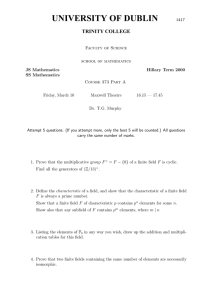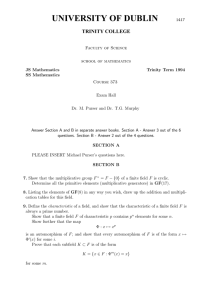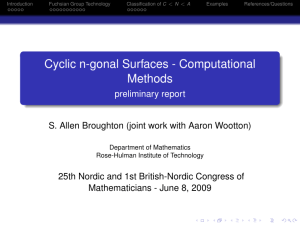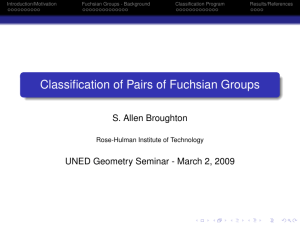Gen. Math. Notes, Vol. 2, No. 2, February 2011, pp.... ISSN 2219-7184; Copyright © ICSRS Publication, 2011
advertisement
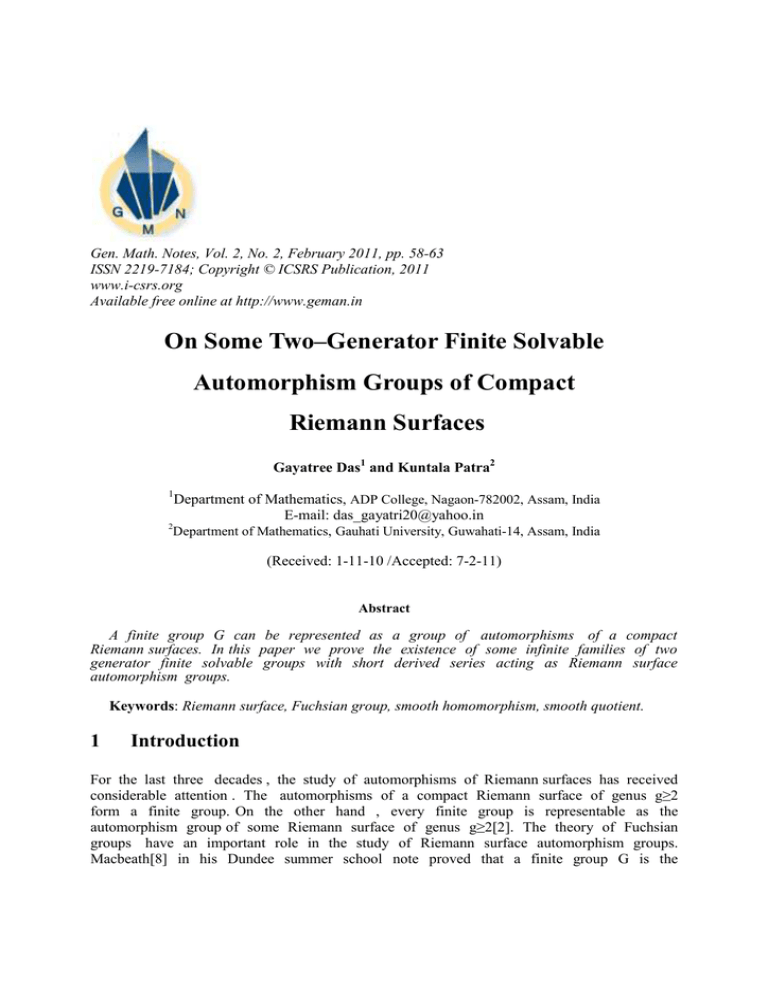
Gen. Math. Notes, Vol. 2, No. 2, February 2011, pp. 58-63
ISSN 2219-7184; Copyright © ICSRS Publication, 2011
www.i-csrs.org
Available free online at http://www.geman.in
On Some Two–Generator Finite Solvable
Automorphism Groups of Compact
Riemann Surfaces
Gayatree Das1 and Kuntala Patra2
1
Department of Mathematics, ADP College, Nagaon-782002, Assam, India
E-mail: das_gayatri20@yahoo.in
2
Department of Mathematics, Gauhati University, Guwahati-14, Assam, India
(Received: 1-11-10 /Accepted: 7-2-11)
Abstract
A finite group G can be represented as a group of automorphisms of a compact
Riemann surfaces. In this paper we prove the existence of some infinite families of two
generator finite solvable groups with short derived series acting as Riemann surface
automorphism groups.
Keywords: Riemann surface, Fuchsian group, smooth homomorphism, smooth quotient.
1
Introduction
For the last three decades , the study of automorphisms of Riemann surfaces has received
considerable attention . The automorphisms of a compact Riemann surface of genus g≥2
form a finite group. On the other hand , every finite group is representable as the
automorphism group of some Riemann surface of genus g≥2[2]. The theory of Fuchsian
groups have an important role in the study of Riemann surface automorphism groups.
Macbeath[8] in his Dundee summer school note proved that a finite group G is the
On Some Two–Generator Finite Solvable…
59
automorphism group of a compact Riemann surface of genus g if and only if it is a
quotient of a ‘Fuchsian’ group by a ‘surface’ group K. Macbeath also showed [8] that
the maximal automorphism groups of compact Riemann surfaces occur as quotients of a
‘special type’ of ‘Fuchsian triangle group’. Similarly Chetiya [3] in his Ph.D. thesis
showed that the maximal solvable automorphism groups are also quotients of a Fuchsian
triangle group having periods 2, 3, 8 .A quotient of a Fuchsian triangle group is a two –
generator group. This shows the importance of finding quotients of different classes of
Fuchsian triangle groups from a strictly theoretic point of view. This was the theme of
the papers by Chetiya [4], [5], Chetiya and Kalita [6], [7] where the existence of several
infinite classes of two generator finite solvable automorphism groups of compact
Riemann surfaces was proved.
In this paper we consider another interesting class of Fuchsian triangle groups and give
a technique to construct infinitely many finite solvable quotients of these groups. Some of
the results given by Chetiya and Kalita [5] ,[6] come out as special cases of those of
ours.
2
Prelimineries
An infinite group Г generated by k elements x1, x2,…………,xk of finite orders
m1,m2,………..,mk respectively and 2γ elements a1,b1,………..,aγ, bγ of infinite orders
satisfying:
K
γ
=……………= = ∏ xi ∏[aj,bj] =1 ……………………………………………(2.1)
i=1
j=1
Where [aj, bj] denotes the commutator of aj, bj ,is called a Fuchsian group if
∂(Г)=2γ_2+ ∏(1 − 1/ ) > 0……………………. ……………………(2.2)
Such a Fuchsian group is usually denoted by ∆(γ; m1,…….,mk) which is called the
signature of the group. The non negative integer γ is called the genus of the group Г. If
γ=0 we simply use the symbol ∆(m1,m2,……….,mk).The integers mi ≥2 are called the
periods of the Fuchsian group. If γ=0, k=3, then Г=∆(m1,m2,m3 ) is called a Fuchsian
triangle group. A Fuchsian group having no elements of finite order except the identities
is called a ‘surface group’. A surface group K is generated by 2g elements of infinite
order and is denoted by ∆(g;0). If K is a surface group of genus g, then
∂(K)=2 (g – 1 ). …….………………………........................(2.3)
Moreover If Г1 is a subgroup of Г of finite index then
[Г: Г1]= ∂ (Г1)/∂(Г) ………………………………………………..(2.4)
If Ф is a homomorphism from the Fuchsian group Г to any finite group G such that
kerФ is a surface group ,then Ф is called a smooth homomorphism and a factor Ѓ/K
where K is a normal surface subgroup of Г is called a smooth quotient of Г.
A Fuchsian group Г is said to satisfy the l.c.m. condition if every period of it divides
the l.c.m. of the remaining periods. The derived group of a Fuchsian group is a surface
group if and only if it satisfies the l.c.m. condition [9]. It is to
be noted that a
necessary condition for a Fuchsian group to satisfy the l.c.m. condition is that it must
have more than one period.
60
3
Gayatree Das et al.
Existence of Solvable Smooth Quotients
We now proceed to find an infinite family of solvable finite smooth quotients of
∆(l,m,n) where
1. ℓ,m, n are positive integers ≥ 2
2. ( ℓ, m )= d1 > 1 (ℓ,n )=d2 >1 (m , n ) =1 and (d1 ,d2 )=1 (for any two positive
integers k1 ,k2 the notation (k1 ,k2 ) is used to denote the h. c .f. of k1 and k2.)
The following lemmas [ lemma 3.1 , lemma 3.2 , lemma 3.3 and lemma 3.4 ] can be found
in Bujalence et al [1] , Chetiya B. P. [4] and Das G .and Patra K [10].
Lemma 3.1 Let Г =∆(γ; m1,……….,mk) be a Fuchsian group with generators x1,……….,xk
of finite order and a1,b1,…………aγ,bγ of infinite order. Let N be a normal subgroup of
Г of finite index. Let pi be the order of the image of xi in the quotient Ѓ/N and let I=
{1≤i≤k; mi≠pi }.Also let ni = mi/pi and si = [ Г : N ]/ pi for every iє I, then N= ∆(γ/; n1,
………,ni ), iє I, where each ni occurs si times and γ/ is obtained from (2.4).
Lemma 3.2 Let K be a Fuchsian surface group of genus g and K/ the derived group of
K. If for each positive integer n , Kn * denotes the subgroup of K generated by the nth
power of all the generators of K, then the product Kn =Kn*K/ is a normal surface
subgroup of K such that [K:Kn]=n2g .
Lemma 3.3 Let Г be a Fuchsian group of non zero genus whose periods satisfy the l.c.m.
condition and let l be the l.c.m. of the periods of Г . If Ѓ is the derived group of Г and
Гkℓ is the subgroup of Г generated by the kℓ –th power ( k≥ 1 ) of the generators of Г,
then Гs =Гkℓ Ѓ is a surface subgroup of Г of finite index for any positive integer k≥1.
Lemma 3.4 Let Г=(γ; m , m,……,m, n) be a Fuchsian group with s -1 occurrences of m,
s≥2, m≥2, n≥2, γ≥1 and (m, n)= 1 . Then for positive integer k, k≥ 2, Г has a Fuchsian
subgroup Гk whose periods satisfy the l. c. m. conditions and Гk is of index d s-2k 2γ
where d =(k,m) in Г.
We are now in a position to give the proof of the theorem on the existence of solvable
smooth quotients of Fuchsian triangle group .
Theorem 3.1 Let Г =(ℓ, m, n ) be a Fuchsian group where ℓ, m, n are positive integers
≥2 such that (ℓ, m )= d1 >1, (ℓ ,n )= d2 >1, (m ,n )= 1 and (d1 ,d2) =1 (as (m, n ) =1). Then
for each positive integer k >1, Г admits smooth quotients of order
/
d1d2 / / ℎ / ℎ / , k>1
and of genus:
/ / (1/(2ℎ ℎ ))〔 / /
/ 〕[ 2 2+A(1+ + − " − # − $ )]+1, Where A=ℎ ℎ k γ , h1= (b
,k) and h2 =(c,k).
Proof:
Let us assume that ℓ =ad1d2, m = bd1 , n= cd2 where a, b , c are prime to each
other.
Let
Г/
be generated by elements x1, x2 and x3 satisfying
" #
$
: = =& =x1x2x3=1
On Some Two–Generator Finite Solvable…
" 61
#
Or equivalently = = ( )$ =1.
Let u1 ,u2 , u3 be the images of x1 , x2 and x3 respectively under the abelianizing
homomorphism From Г onto Г( . Then Г( is generated by u1, u2 and u3 satisfying:
Ѓ
Ѓ
" #
$
) = ) = )& =u1u2u3 = 1.
" #
Or ) = ) =() ) )$ = 1.
The above relation gives ,
) = 1 as
() ) )$ =1
$
$
=> ) ) =1
=> ) u2=1
=> u2 = u1-d2.
" #
Now,
) =) =1
" =>) = (u1-d2)bd1 =1
" # =>) =) =1.
Therefore ) =1, as ( a ,b ) =1.
So,
Γ/Ѓ≅ - By lemma 3.1
Ѓ= ( ´ ;a, b,..………,b c ,………c )
d1-times
.
(3.1.1)
d2-times
´
And we get
=1/2 [ ( d1-1)(d2 -1) ].
By lemma 3.4 , Ѓ has a subgroup Гk , k>1 0f finite index whose periods satisfy the
l.c.m. condition.
Let Г*k = {xk , xє Ѓ } be a subgroup of Ѓ, for k≥2. Let Гk= Г*k Ѓ΄, then by lemma
(3.2 ) Гk is normal in Ѓ of finite index .
As Ѓ⊆Гk ⊆Ѓ , so Ѓ/Гk is abelian .
Consider an abelianizing homomorphism :
Ф :Ѓ →Ѓ/Гk
´
´
Let u,)´ ,……….., )
,.´ ,………,.
, a1 ,b1 ,……….. , ´ , ´ be
the images of x
´
´
´
´
´
´
, ,………, , 0 , … ., 0 , α1, β1,……. α , β respectively under the above mentioned
homomorphism satisfying the conditions:
´$
´$
´
´
´
´
ua= u´ # =…….= u´#
= v =……= v =)) ……u . …... =1
uk = u´ =…..= u´ = v´ =…….= v´ = a1k =b1k=…….= a´ = b´ =1,
where the elements commute with each other.
If (b,k)=h1≥1,(c,k)=h2≥1, then the above relation give:
u1´h1=…….=ud2´h1=v1´h2=……=vd1´h2 =1
and the elements commutes with each other.
We conclude that ,
Ѓ/Гk≅ - ⊕…………………………⊕- ⊕- ……………….…⊕- ⊕zk⊕ …………………..⊕zk
62
Gayatree Das et al.
(6 -1)summands
Therefore
(6 -1)summands
´
Ѓ/Гk =ℎ ℎ By lemma 3.1 we get,
´
2
= A, say .
−summands
(3.1.2)
Гk= γk; a,…….,a,b/h1,…… .., b/h1,c/h2,……..,c/h2
A-times
7/ 89:
7/89:
Since the periods of Гk satisfy the l.c.m. condition, therefore Ѓk− is a surface group. The
genus of γk calculated from lemma 3.1 is,
γk=
2
´
−2+d2(1− #)+d1(1− $ )- + # + $ +1.
By lemma 3.3 let us construct another subgroup ;∗ generated by t-th (t>1) power of the
infinite order generators of Гk.
Let N=;∗ ;´ , then N is normal in Гk of finite index and Гk/N is abelian as ;´ ⊆ ;∗ ;´ =
N.
We now have,
Гk/N≅za⊕………………⊕za⊕=#( ………….…⊕=#(
(A-1)summands
Where ℓ´=
Therefore
(
7( -1)summands
ℎ
⊕=$(
⊕…………..⊕=$(
7( -1)summands
ℎ
⊕=8ℓ´ ⊕…………….⊕=8ℓ´
(
2
summands
"#$
is the l.c.m. of the periods of Гk.
Гk/N =aA-1((ℎ )A/ℎ -1 ((ℎ )A/ ℎ -1 (t ℓ´)2γk
=
8 >
E
?
C
>B CFAγGB
@
A
D
=B, say
[aA+2γk-1bA/ℎ +2γk-1cA/h2+2γk-1]
( 3.1.3)
Where A is given by (3.1.2).
By lemma 3.1 we have N=(γn; …….).
Since N is a surface group and therefore G=Г(N is a smooth quotient of Г and the
genus obtained from (2.4) is
I
γn = 〔2 −2+A(1+ + - − - )〕+1.
"
#
$
,
Where A and B are given by (3.1.2 ) and (3.1.3) respectively. Therefore we have
γn =
$
8 >
E
?
CFAγ
C
>
GB
@ A B D
)+1.
[aA+2γk-1bA/ℎ +2γk-1cA/ℎ +2γk-1]
2
−2+A(1+
+
-
"
−#-
On Some Two–Generator Finite Solvable…
Now the order of G is
ℎ
/ , k>1
;
G = ;(K = ;( ;(; (K
Ѓ
= d1d2 ´ 63
/ / ℎ /
Thus Г admits smooth quotients ,but we cannot say whether it is solvable or not. This
completes the proof of the theorem.
Remark 1: If a=b=c=1, then Г admits abelian smooth quotient of order d1d2 and of
genus
/
[(d1-1)(d2-1)] as well as metabelian smooth quotient of order d1d2 and of genus,
() [ (d1-1)(d2-1)-1]+1, for k≥1.
Remark 2: If a=1 and b, c >1 then Г admits a metabelian smooth quotient of order
´
´
d1d2 ´ , k≥1 and of genus
´ ´ ´
6
6
[d1d2- (- ( -1]+1; k≥1,
Where
´ =
(d1-1)(d2-1).
References
[1]
[2]
[3]
[4]
[5]
[6]
[7]
[8]
[9]
[10]
E. Bujalance, J.M. Gamboa and G. Gromadjki, The full automorphism groups of
hyperelliptic Riemann surfaces, Manuscripta Math., 79 (1993), 267-82.
W. Burnside, Theory of Groups of Finite Order, Dover publications, inc., New York
(1955).
B.P. Chetiya, Groups of automorphisms of compact Riemann surfaces, Ph.D. Thesis,
Birmingham univ, (1971).
B.P. Chetiya, On genuses of compact Riemann surfaces, admitting solvable
automorphism groups, Indian J. Pure Appl. Math., 12(11) (1981), 1312-18.
B.P. Chetiya, On solvable surface kernel factor groups of (2,3,3m),m>=3, J. Assam Sc.
Soc., 28(2) (1986), 47-52.
B.P. Chetiya and S.C. Kalita, Some automorphism groups of compact Riemann surfaces
of small genus, Indian J. Pure Appl. Math., 14(7) (1983), 830-837.
B.P. Chetiya and S.C. Kalita, On solvable automorphism groups of compact Riemann
surfaces, Indian J. Pure Appl. Math., 15(9) (1984), 978-983.
A.M. Macbeath, Discontinuous groups and birational transformations, Proc. of Summer
School in Geometry and Topology, Queen's college, Dundee (1961).
C. Maclachlan, Smooth coverings of hyperelliptic surfaces, Qurt. J. Math. Oxford, (2)22
(1971), 117-23.
G. Das and K. Patra, On some two generator finite solvable automorphism groups of
compact Riemann surfaces, The Bulletin, GUMA., 5 (1998), 49-56.




